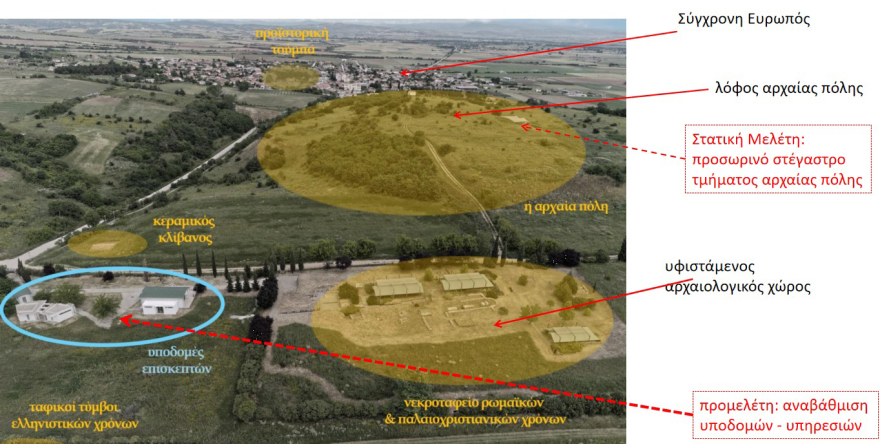The program involves projects for the improvement and expansion of the infrastructure and services of the archaeological site, as well as the installation of a temporary protective shelter in part of the ancient city. Through these specific interventions, the functionality of the archaeological site and the overall visitor experience are enhanced, while simultaneously supporting the educational and cultural activities of the Antiquities Service at ancient Europos.
Ancient Europos was a significant city at the heart of the Macedonian kingdom, with a timeless history, as evidenced by the archaeological research in the city and its cemeteries. Known as “Europaion Polis,” according to an inscription from the 2nd century BC, its impressive finds provide all the conditions for its development into an important cultural hub and developmental resource for the region and Central Macedonia at large.

The Minister of Culture, Lina Mendoni, stated: “The upgrading and promotion of the ancient city of Europos, the birthplace of Seleucus I Nicator, the successor of Alexander the Great and founder of the Seleucid dynasty, is a goal of the Ministry of Culture and the relevant Antiquities Service. The promotion of this significant archaeological site, with the enhancement of its recognition as a destination with cultural and developmental dynamics, aims to integrate it into the cultural and developmental map of Central Macedonia, in line with our strategic planning for Macedonia.
In the 2000s, with the completion of building infrastructure for public service, the site became accessible. However, it operated sporadically. In 2019, the operation of the Information Center significantly enhanced visitor traffic by improving information about the long history of ancient Europos, its city, and its cemeteries, as well as the leader of the Seleucid dynasty. Since then, regular educational programs and cultural activities have been held at the promoted archaeological site, contributing to better acquaintance of visitors of all ages with ancient Europos and understanding its historical significance.

Now, with the newly planned interventions we have approved, which include the installation of lighting for the enhancement and safety of the archaeological site, we renew and upgrade its infrastructure, fully meeting its modern needs and overall improving its operation while also ensuring the protection of its archaeological remains.”
The accessible archaeological site includes part of the cemetery dating back to Roman and early Christian times, a section of the urban fabric of the ancient city on a hill, with houses, storage facilities, and workshops north of the cemetery, which date to at least two residential phases of late antiquity (4th – 6th century BC).
The archaeological site also includes a cluster of three tombs (late 4th – early 3rd century BC), the burial complex of Mesia, and a prehistoric tumulus from the Neolithic period (5th millennium BC) within the modern settlement of Europos. The city had a dense urban network with streets and houses, while the “industrial” zone developed next to a nearby stream. The existence of an organized water supply network with an aqueduct is confirmed by an inscription stating that the project was funded by Philip of Macedon (2nd – 3rd century AD).
The habitation of Europos was continuous from the 5th pre-Christian millennium BC until the 6th century AD. Europos is also the origin of the unique Kouros excavated in northern Greece.
Ask me anything
Explore related questions





